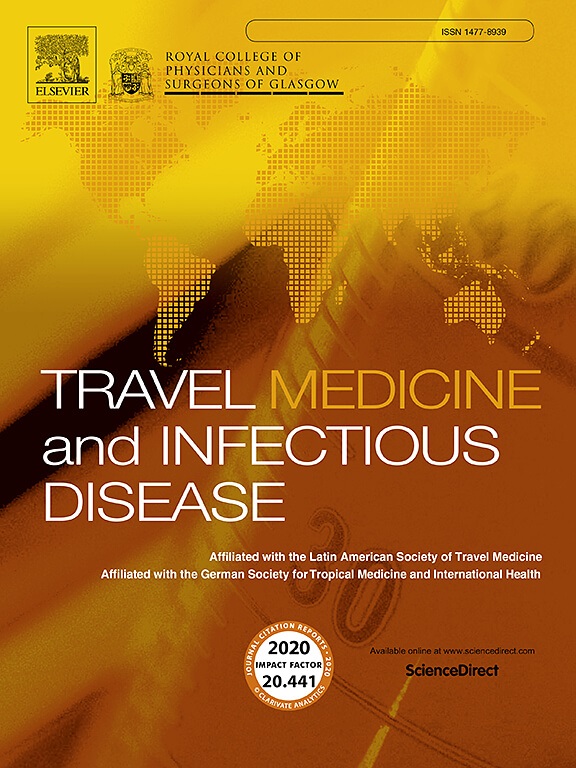加蓬Loa Loa高流行区皮肤应用节肢动物驱蚊剂对金蛉叮咬的保护效果:避蚊胺、心红素、柠檬醇和IR3535的安慰剂对照随机临床试验
IF 4.7
3区 医学
Q1 INFECTIOUS DISEASES
引用次数: 0
摘要
loa loa是一种引起loasis的丝状病原体,由鹿蝇种Chrysops dimidiata和C. silacea传播。没有既定的控制工具可用于减少地方病传播。虽然对其他节肢动物使用驱蚊剂进行了探索,但对人类对金蛹叮咬的保护效果尚未进行系统评估。这项随机对照临床试验的目的是评估加蓬高流行地区四种商业皮肤应用节肢动物驱避剂对金蛉叮咬的效果。方法志愿者被随机分配使用避蚊胺、心红素、柠檬醇、IR3535或无活性对照。研究的主要终点是金蝇尝试吸血的次数。次要结局是白蛉落在衣服和皮肤上的频率和持续时间。本研究已在泛非临床试验注册中心注册(PACTR202406779622099)。结果柠檬酸二醇(- 50%,p = 0.04)和避蚊胺(- 50%,p < 0.001)显著降低了血餐次数,但伊卡苷(0%,p = 0.48)和IR3535 (0%, p = 0.69)没有显著降低血餐次数。同样,柠檬酸二醇(- 66%,p = 0.02)和避蚊胺(- 46%,p < 0.001)显著缩短了苍蝇在皮肤上停留的时间,但鸢尾素(+ 2%,p = 0.35)和IR3535 (0%, p = 0.93)没有显著缩短。相反,避蚊胺和鸢尾素对未处理衣物上的瓢虫数量没有减少,而柠檬醇和IR3535处理的个体则有更多的瓢虫降落(p = 0.005和p = 0.01)。结论氯吡二醇和避蚊胺对蜱病媒介的叮咬有一定的保护作用,但保护作用不完全。Icaridin和IR3535无效。本文章由计算机程序翻译,如有差异,请以英文原文为准。
Protective efficacy of skin-applied arthropod repellents against Chrysops bites in a Loa loa hyperendemic region in Gabon: A placebo-controlled randomized clinical trial of DEET, icaridin, citriodiol, and IR3535
Background
Loa loa – a filarial pathogen causing loiasis –is transmitted by deer fly species Chrysops dimidiata and C. silacea. There are no established control tools available to reduce loiasis transmission in endemic regions. Although the use of repellents has been explored against other arthropods, their protective efficacy against Chrysops bites in humans has not yet been systematically evaluated. The aim of this randomized controlled clinical trial was to assess the efficacy of four commercial skin-applied arthropod repellents against Chrysops bites in a hyperendemic region in Gabon.
Methods
Volunteers were randomly assigned to apply the skin repellents DEET, icaridin, citriodiol, IR3535 or an inactive control. The primary endpoint was the number of blood meal attempts by Chrysops flies. Secondary outcomes were the frequency and duration of Chrysops landings on clothing and skin. This study is registered with the Pan African Clinical Trials Registry (PACTR202406779622099).
Results
Blood meal attempts were significantly reduced by citriodiol (−50 %, p = 0.04) and DEET (−50 %, p < 0.001), but not by icaridin (0 %, p = 0.48) and IR3535 (0 %, p = 0.69). Concordantly, the time spent by the fly on the skin was significantly shortened by citriodiol (−66 %, p = 0.02) and DEET (−46 %, p < 0.001), but not with icaridin (+2 %, p = 0.35) and IR3535 (0 %, p = 0.93). Conversely, the number of Chrysops landings on untreated clothing was not reduced by DEET and icaridin, while citriodiol and IR3535 treated individuals experienced a higher number of landings (p = 0.005 and p = 0.01, respectively).
Conclusions
Citriodiol and DEET showed substantial but not complete protective efficacy against the bite of loiasis vectors. Icaridin and IR3535 were ineffective.
求助全文
通过发布文献求助,成功后即可免费获取论文全文。
去求助
来源期刊

Travel Medicine and Infectious Disease
PUBLIC, ENVIRONMENTAL & OCCUPATIONAL HEALTH-INFECTIOUS DISEASES
CiteScore
19.40
自引率
1.70%
发文量
211
审稿时长
49 days
期刊介绍:
Travel Medicine and Infectious Disease
Publication Scope:
Publishes original papers, reviews, and consensus papers
Primary theme: infectious disease in the context of travel medicine
Focus Areas:
Epidemiology and surveillance of travel-related illness
Prevention and treatment of travel-associated infections
Malaria prevention and treatment
Travellers' diarrhoea
Infections associated with mass gatherings
Migration-related infections
Vaccines and vaccine-preventable disease
Global policy/regulations for disease prevention and control
Practical clinical issues for travel and tropical medicine practitioners
Coverage:
Addresses areas of controversy and debate in travel medicine
Aims to inform guidelines and policy pertinent to travel medicine and the prevention of infectious disease
Publication Features:
Offers a fast peer-review process
Provides early online publication of accepted manuscripts
Aims to publish cutting-edge papers
 求助内容:
求助内容: 应助结果提醒方式:
应助结果提醒方式:


